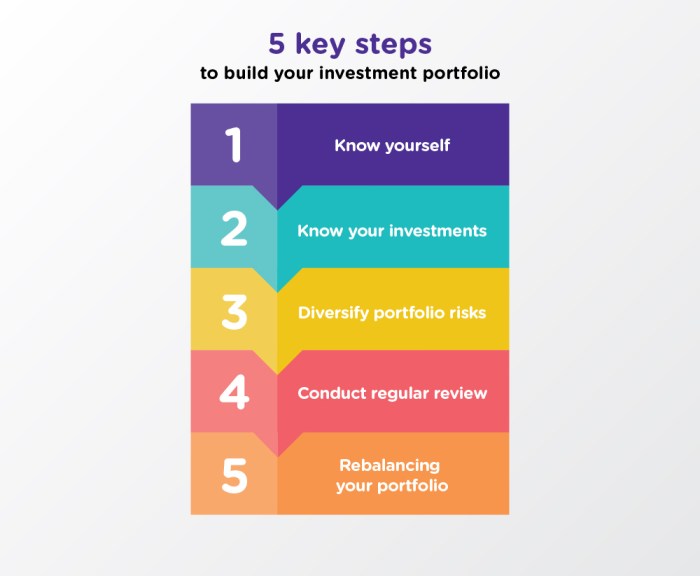Get ready to dive into the world of investment portfolios, where strategic decisions pave the way to financial growth and stability. Buckle up as we explore the ins and outs of crafting a winning investment strategy that suits your goals and risk tolerance.
In this guide, we’ll break down the essential steps to building a robust investment portfolio that sets you up for long-term success.
Understanding Investment Portfolios
Investment portfolios are a collection of assets like stocks, bonds, real estate, and other investments held by an individual or organization. The goal is to achieve a balance between risk and return by spreading investments across different asset classes.
Importance of Diversification
Diversification is crucial in building an investment portfolio as it helps reduce risk. By spreading investments across various asset classes, industries, and geographical regions, investors can minimize the impact of a decline in any single investment.
- Diversification lowers the overall risk of the portfolio.
- It can help smooth out fluctuations in returns over time.
- Provides exposure to different market sectors, reducing vulnerability to specific economic events.
Diversification is like not putting all your eggs in one basket.
Key Benefits of a Well-Structured Investment Portfolio
A well-structured investment portfolio offers several advantages to investors, including:
- Potential for higher returns compared to simply holding cash.
- Ability to customize the portfolio to align with specific financial goals and risk tolerance.
- Opportunity to benefit from compounding returns over time.
Setting Investment Goals
Setting investment goals is a crucial step in building a successful investment portfolio. By clearly defining your goals, you can tailor your investment strategy to meet your specific needs and objectives. Whether you are investing for the short-term or long-term, having a clear vision of what you want to achieve will guide your decision-making process.
Defining Investment Goals
When setting investment goals, it is important to consider your financial situation, risk tolerance, time horizon, and desired outcomes. Some common examples of investment goals include:
- Short-term goals: Saving for a vacation, purchasing a new car, or building an emergency fund.
- Long-term goals: Retirement planning, buying a home, funding a child’s education, or achieving financial independence.
Setting clear investment goals helps you prioritize your financial objectives and align your investment portfolio with your aspirations. It also allows you to measure your progress and make necessary adjustments along the way to stay on track towards achieving your goals.
Assessing Risk Tolerance
Determining your risk tolerance is a crucial step before building an investment portfolio. It helps you understand how much volatility and uncertainty you can handle in your investments.
Different Risk Tolerance Levels
- Conservative: Investors with a conservative risk tolerance prefer low-risk investments like bonds or certificates of deposit. They prioritize capital preservation over high returns.
- Moderate: Moderate risk investors are willing to accept some fluctuations in the value of their investments. They typically have a balanced mix of stocks and bonds in their portfolio.
- Aggressive: Aggressive investors are comfortable with high levels of risk and volatility in exchange for the potential of higher returns. They often have a significant portion of their portfolio in stocks or alternative investments.
Methods to Assess Risk Tolerance
- Questionnaires: Many financial institutions offer risk tolerance questionnaires that help investors gauge their risk appetite based on their answers to various scenarios and questions.
- Professional Advisors: Consulting with a financial advisor can provide personalized guidance on risk tolerance by analyzing your financial goals, time horizon, and comfort level with market fluctuations.
- Self-Assessment: Reflecting on past investment experiences, understanding your emotional response to market ups and downs, and evaluating your long-term financial goals can also help assess your risk tolerance.
Asset Allocation
Asset allocation is a crucial component in building a well-rounded investment portfolio. It involves dividing your investments among different asset classes to manage risk and maximize returns. By spreading your investments across various types of assets, you can reduce the impact of volatility in any one market or sector.
Different Asset Classes
- Stocks: Represent ownership in a company and offer potential for high returns but come with higher risk.
- Bonds: Debt securities issued by governments or corporations, providing income through interest payments.
- Real Estate: Includes properties like residential, commercial, or land, offering potential for appreciation and rental income.
- Commodities: Raw materials or primary agricultural products, providing diversification and protection against inflation.
- Cash Equivalents: Low-risk investments like money market funds or certificates of deposit, offering liquidity and stability.
Effective Asset Allocation Strategies
- Consider Your Risk Tolerance: Determine how much risk you are willing to take based on your financial goals and comfort level.
- Align with Investment Goals: Allocate assets based on your objectives, whether it’s growth, income, or capital preservation.
- Diversify Across Asset Classes: Spread investments across different types of assets to reduce risk and enhance potential returns.
- Rebalance Regularly: Monitor your portfolio and adjust asset allocation periodically to maintain desired risk levels and meet goals.
- Seek Professional Advice: Consult with financial advisors or experts to help optimize your asset allocation strategy.
Choosing Investments

When it comes to building an investment portfolio, choosing the right investments is crucial for achieving your financial goals. Researching and selecting suitable investments requires careful consideration and a good understanding of the market. Here’s how you can make informed decisions when choosing individual stocks, mutual funds, or ETFs, and how to diversify your investments within each asset class.
Factors to Consider when Choosing Investments
- Performance History: Look at the past performance of the investment to assess its potential for future growth.
- Risk Level: Evaluate the risk associated with the investment and determine if it aligns with your risk tolerance.
- Expense Ratios: Consider the fees and expenses associated with the investment, as they can impact your overall returns.
- Market Trends: Stay informed about market trends and economic indicators that may affect the performance of the investment.
Tips for Diversifying Investments within Each Asset Class
- Spread Your Investments: Avoid putting all your money into one stock or fund; diversify across different industries and sectors.
- Asset Allocation: Allocate your investments across different asset classes, such as stocks, bonds, and real estate, to reduce risk.
- Rebalance Regularly: Monitor your portfolio regularly and rebalance it as needed to maintain your desired asset allocation.
- Consider Your Goals: Align your investment choices with your financial goals and time horizon to create a well-rounded portfolio.
Portfolio Monitoring and Rebalancing
Regularly monitoring your investment portfolio is crucial to ensure that it aligns with your financial goals and risk tolerance. Monitoring allows you to track the performance of your investments and make adjustments as needed to maintain the desired asset allocation.
Importance of Portfolio Monitoring
- Monitoring helps you stay informed about how your investments are performing.
- It allows you to identify any underperforming assets that may need to be replaced.
- By monitoring regularly, you can take advantage of opportunities to buy or sell investments at the right time.
Rebalancing Your Portfolio
- Rebalancing involves adjusting your portfolio back to its original asset allocation mix.
- It should be done periodically, typically annually or semi-annually, or when your portfolio drifts significantly from your target allocation.
- Rebalancing ensures that you are not taking on more risk than you are comfortable with and helps maintain a diversified portfolio.
Tools and Techniques for Portfolio Monitoring
- Use online portfolio trackers or investment management platforms to monitor the performance of your investments.
- Track key performance indicators such as return on investment, volatility, and correlation with the market.
- Consider using a spreadsheet to track your investments and calculate your portfolio’s asset allocation.










